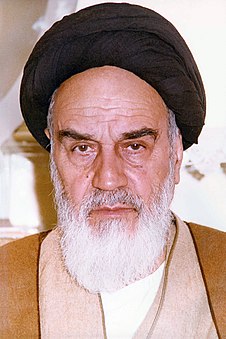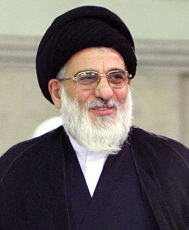| |||||||||||||
86 Members in the Assembly of Experts 58 votes needed to win | |||||||||||||
|---|---|---|---|---|---|---|---|---|---|---|---|---|---|
| Turnout | 86.04% | ||||||||||||
| |||||||||||||
| |||||||||||||
The Supreme Leader of Iran election, 1989 was an indirect election where the Assembly of Experts members voted to choose the second Supreme Leader of Iran. The election was held on June 4, 1989, the morning after Ruhollah Khomeini's death and Ali Khamenei was elected as his successor with 60 votes out of 74. [1]
An indirect election is an election in which voters do not choose between candidates for an office, but elect people who then choose. It is one of the oldest forms of elections, and is still used today for many presidents, cabinets, upper houses, and supranational legislatures. Presidents and prime ministers can be indirectly elected by parliaments or by a special body convened solely for that purpose. The election of the executive government in most parliamentary systems is indirect: elect the parliamentarians, who then elect the government including most prominently the prime minister from among themselves. Upper houses, especially of federal republics, can be indirectly elected by state legislatures or state governments. Similarly, supranational legislatures can be indirectly elected by constituent countries' legislatures or executive governments.

The Assembly of Experts —also translated as the Assembly of Experts of the Leadership or as the Council of Experts— is the deliberative body empowered to designate and dismiss the Supreme Leader of Iran. However all directly-elected members after the vetting process by the Guardian Council still have to be approved by the Supreme Leader of Iran before gaining membership to the Assembly of Experts.

The Supreme Leader of Iran, also referred to as Supreme Leader of the Islamic Revolution, but officially called the Supreme Leadership Authority, is the head of state as well as the ultimate political and religious authority of the Islamic Republic of Iran. The armed forces, judiciary, state television, and other key government organizations are subject to the Supreme Leader. The current longtime officeholder, Ali Khamenei, has been issuing decrees and making the final decisions on economy, environment, foreign policy, education, national planning, and everything else in Iran. Khamenei also makes the final decisions on the amount of transparency in elections, and has dismissed and reinstated presidential cabinet appointees. The Supreme Leader directly chooses the ministers of Defense, Intelligence and Foreign Affairs, as well as certain other ministers, such as the Science Minister. Iran's regional policy is directly controlled by the office of the Supreme Leader with the Ministry of Foreign Affairs' task limited to protocol and ceremonial occasions. All of Iran's ambassadors to Arab countries, for example, are chosen by the Quds Corps, which directly report to the Supreme Leader.
According to the testimony of Akbar Hashemi Rafsanjani in the chamber before voting, in accordance with Ruhollah Khomeini's wish, Ali Khamenei was a suitable successor for him. He testified that in a meeting in late March 1989, Ruhollah Khomeini was asked about lack of a suitable successor for him after Hussein-Ali Montazeri was deposed and then he replied that Ali Khamenei is suitable. [2]

Akbar Hashemi Rafsanjani was an influential Iranian politician, writer and one of the founding fathers of the Islamic Republic who was the fourth President of Iran from 3 August 1989 until 3 August 1997. He was the head of the Assembly of Experts from 2007 until 2011, when he decided not to nominate himself for the post. He was also the chairman of the Expediency Discernment Council.

Sayyid Ruhollah Mūsavi Khomeini, known in the Western world as Ayatollah Khomeini, was an Iranian politician and marja. He was the founder of the Islamic Republic of Iran and the leader of the 1979 Iranian Revolution that saw the overthrow of the last Shah of Iran, Mohammad Reza Pahlavi, and the end of 2,500 years of Persian monarchy. Following the revolution, Khomeini became the country's Supreme Leader, a position created in the constitution of the Islamic Republic as the highest-ranking political and religious authority of the nation, which he held until his death. He was succeeded by Ali Khamenei on 4 June 1989.

Sayyid Ali Hosseini Khamenei is a marja and the second and current Supreme Leader of Iran, in office since 1989. He was previously President of Iran from 1981 to 1989. Khamenei is the second-longest serving head of state in the Middle East, as well as the second-longest serving Iranian leader of the last century, after Shah Mohammed Reza Pahlavi.
| “ | Imam said: Why [do you think] we don't have [anyone suitable]? Mr. Khamenei [is suitable]. | ” |
| — Akbar Hashemi Rafsanjani [2] | ||













